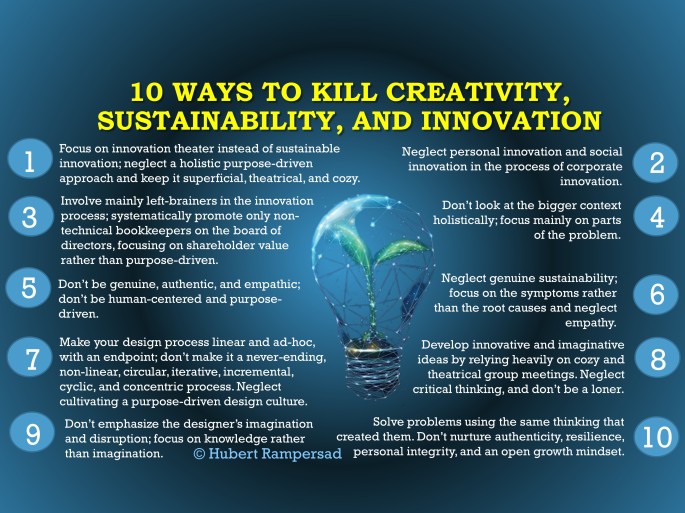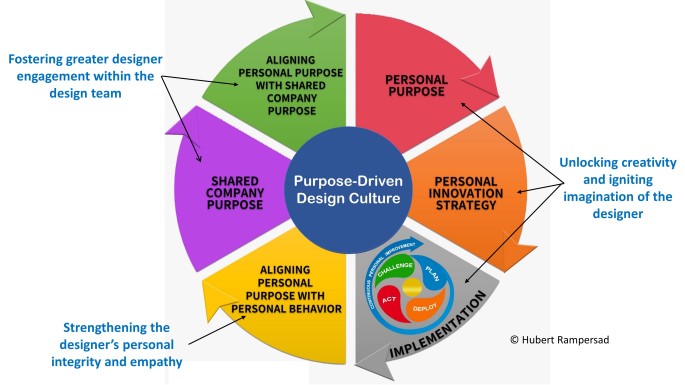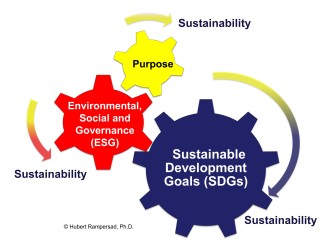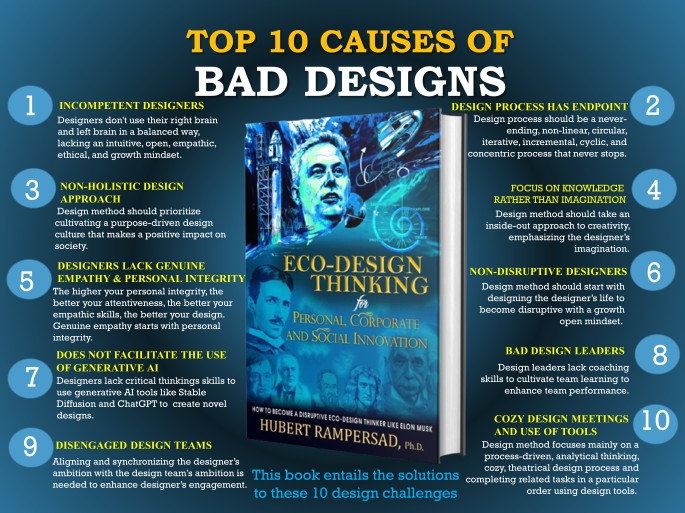Hubert Rampersad, Ph.D.
The era of design thinking has come to an end. Read the MIT Technology Review article “Design thinking was supposed to fix the world. Where did it go wrong? An approach that promised to democratize design may have done the opposite” (2023). We need to evolve beyond design thinking in the age of AI. The AI industry needs a radical new design approach that goes far beyond the original design thinking methodology. It needs a holistic, sustainable, purpose-driven design culture rather than relying on a theatrical and ad-hoc design process that involves cozy design meetings with sticky notes and fun design tools. I have described this in detail in my new article “The End of The Design Thinking Era: The Future of Industrial Design Innovation”.
To move forward, we must reimagine design innovation with sustainability at its core. This means shifting our focus away from rigid design steps and tools and fostering a sustainable purpose-driven design culture. Tech companies must focus beyond shareholder value and prioritize social responsibility. Boeing, for instance, should balance its focus on profits with a commitment to sustainable practices. Read “Boeing’s Top 10 Failures”.
These “10 Ways to Kill Creativity, Sustainability, and Innovation” apply to Boeing.

Purpose-Driven Design Culture in the Age of AI
Technology companies should prioritize cultivating a purpose-driven design culture based on eco-design thinking as a fundamental capability to achieve sustainable growth and competitive advantage. These companies are not only focused on profitability but also on making a positive impact on society. They go beyond merely understanding what customers want and why they like it. Look what happened with Boeing due to the lack of a purpose-driven design culture. Read: “Boeing lost its way. Other companies should take heed”; “It’s become clear that Boeing’s problems run far deeper. They expose decades of American corporate philosophy gone awry. Boeing is a quintessential example of America’s rotting business culture over the past 40 years” (Markets Insider). Boeing focused on pleasing Wall Street because that’s how American executives believe companies should operate. The people who are at the top are there for a reason, and it’s basically to maximize shareholder value. Changing CEOs or hiring more engineers won’t eliminate Boeing’s problems. The company needs to rethink its reason for existing and what it should provide to society as an enterprise.
A holistic model for building a sustainable purpose-driven design culture
Tech companies should prioritize profits and promote values, high character, and ethical critical thinking among their employees. This will help impact our society’s well-being, integrity, and empathy positively. In this section, I provide a holistic model to realize this sustainably, as shown in this diagram. This model is based on my latest book, “Eco-Design Thinking for Personal, Corporate, and Social Innovation.” It is also based on my experience as a senior design innovation coach at ASML, the most crucial tech company in the world and Europe’s most valuable tech firm, the only tech company in the world with a sustainable design-driven culture.

This holistic, never-ending, purpose-driven cycle entails six stages that has been described in detail in my article “Sustainable Innovation Fueled by Purpose-Driven Culture“. We provide free initial consultation to tech companies to build a sustainable purpose-driven design culture, improve their design process, and boost their design team performance, read “Complimentary Initial Consultation to Enhance Your Design Process and Boost Design Team Performance”. In the following sections, I will focus on building a purpose-driven design-culture based on my eco-design thinking model. Read also “How SDGs, ESG, and Purpose Fuel Design For Sustainability”.
tech companies to build a sustainable purpose-driven design culture, improve their design process, and boost their design team performance, read “Complimentary Initial Consultation to Enhance Your Design Process and Boost Design Team Performance”. In the following sections, I will focus on building a purpose-driven design-culture based on my eco-design thinking model. Read also “How SDGs, ESG, and Purpose Fuel Design For Sustainability”.
A purpose-driven design culture requires a new way of thinking
A purpose-driven design culture needs a new way of thinking. As Einstein once said, “We cannot solve our problems with the same thinking we used when we created them.” That’s where eco-design thinking emerges, shifting from the traditional fixed mindset to a more dynamic growth mindset. The difference between these two approaches is illustrated in the diagram below.

Many designers favor their brain’s left side and ignore the right, resulting in a lack of balance. This limits their ability to approach complex design issues creatively and with authenticity.
A purpose-driven design culture requires a new generation of brilliant engineers
We need a new generation of brilliant engineers in the age of AI with a new mindset to design a better world and create a vibrant future. Engineers must possess skills like creativity, imagination, agility, critical thinking, and sustainability to become visionary and innovative entrepreneurial leaders or to design innovative products. These skills are not typically associated with engineering, but the rapid rate of technological change has made most college and university courses obsolete by the time students graduate. Read “We Need a New Generation of Brilliant Engineers“.
STEM programs give engineers insights into science, technology, engineering, and mathematics. However, they often fail to nurture the holistic, authentic, and imaginative qualities essential for tomorrow’s engineers. Read “How STEM Education is Failing in the Age of AI”.
A Purpose-driven design culture requires sustainable innovation
In today’s complex world, sustainable innovation is crucial. Traditional innovation approaches are inadequate because they lack a holistic approach. This is why I introduced my Eco-Innovation concept, which focuses on the human side of innovation.

Eco-Innovation involves integrating sustainability into the process of innovation. I identify three types of innovation that fall under this category:
- Personal innovation is unlocking your creative potential and creating new opportunities for yourself. By disrupting your current market, you can make a significant social impact. Personal Disruptive Innovation by Hubert Rampersad helps you find your purpose and improve your life for greater happiness and health.
- Corporate innovation involves applying new ideas to create new products, processes, or services that increase the value of a company. Corporate innovation also encompasses Open Innovation by Chesbrough, Disruptive Innovation by Clayton Christensen, and BlockChain Innovation.
- Social innovation is developing and implementing new ideas and solutions that meet social needs and strengthen civil society. There is some overlap between social innovation and social entrepreneurship. Social innovation aims to improve the world by implementing innovative ideas that create social and environmental change, benefiting many people. Social entrepreneurs seek the most effective ways to achieve their social mission and provide social benefits.
The diagram below shows how personal, corporate, and social innovation are interconnected. Personal innovation is linked to self-learning, corporate innovation is linked to organizational learning, and social innovation is linked to community learning.
Personal Disruptive Innovation
Personal disruptive innovation is an innovative approach that unlocks your creative potential by cultivating a strong growth mindset, creating new unique opportunities, disrupting your current target market, and allowing you to make a significant social impact. It involves five steps, as shown in this model: 1. Personal Ambition, 2. Personal Brand, 3. Personal Innovation Strategy, 4. Implementation, and 5. Personal Integrity & Empathy.
The roadmap for personal disruptive innovation begins with personal ambition (personal mission, vision, and key roles), founded on self-knowledge. It’s important to remember that all knowledge begins with self-knowledge, all learning begins with self-learning, all innovation starts with self-innovation (personal innovation), and authentic empathy begins with personal integrity. Self-knowledge involves knowing oneself. Remember what Aristotle said: “Knowing yourself is the beginning of all wisdom.” To be more innovative and creative, designers should focus more on cultivating self-knowledge, which is the foundation of imagination. Read “ Why Creativity Sucks“.
Why Creativity Sucks“.
By defining your personal ambition, you can uncover your true purpose and understand the meaning of your life. Remember what Elon Musk said: “Don’t even attach yourself to a person, a place, a company, an organization, or a project. Attach yourself to a mission, a calling, a purpose only. That’s how you keep power and your peace. It worked pretty well for me this far”. The 5 stages in the personal disruptive innovation model have been described in detail in my articles “5 Steps to Cultivate Authenticity, Integrity, Empathy, and Critical Thinking” and “Cultivating Critical Thinking in the Age of AI”.
To be discussed in the next section, the eco-design thinking model starts with personal disruptive innovation to understand, explore, redefine, and redesign yourself before solving the design problem. You need to become innovative and empathic first to develop innovative designs for the end users. You need to develop disruptive skills first. You need to reinvent and redesign yourself first to become a disruptor. In the upcoming section, I will discuss the eco-design thinking model, which emphasizes personal disruptive innovation as the first step towards understanding, exploring, redefining, and redesigning oneself before solving any design problems. Being innovative and empathic is essential to developing innovative designs that cater to the end users’ needs. Therefore, developing disruptive skills and reinventing oneself to become a critical thinker is necessary.
Top 10 Causes of Bad Designs
My article “Top-10 Causes of Bad Designs” highlights the negative impact of bad designs due to a lack of consideration for sustainability and generative AI. Some well-known examples of such methods include the botched vaccine rollout in America, Citibank’s loss of $500 million due to an unfriendly loan management tool, the $2 trillion F-35 project, Boeing 737 Max airplane, the T-14 Armata Russian Tank, and the Samsung. Galaxy Note 7. Please take the time to read my article “Why OceanGate’s Design Approach Sucks; How the Doomed Titan Sub Tragedy Could Have Been Avoided.” CEOs who prioritize their personal design choices over critical safety regulations, endangering human lives, can learn a valuable lesson from the tragedy of the Titan. This also applies to individuals like Elon Musk and companies like Boeing. Please look at my article “How could Elon Musk’s $3 billion Mars rocket failure have been avoided?”. The following figure displays the top 10 reasons for bad designs.
Galaxy Note 7. Please take the time to read my article “Why OceanGate’s Design Approach Sucks; How the Doomed Titan Sub Tragedy Could Have Been Avoided.” CEOs who prioritize their personal design choices over critical safety regulations, endangering human lives, can learn a valuable lesson from the tragedy of the Titan. This also applies to individuals like Elon Musk and companies like Boeing. Please look at my article “How could Elon Musk’s $3 billion Mars rocket failure have been avoided?”. The following figure displays the top 10 reasons for bad designs.

Read “How the Boeing 737 Max Incidents Could Have Been Avoided”.

Eco-Design Thinking as part of a purpose-driven design culture
As mentioned, the world has no shortage of complex problems to address. These problems cannot be solved sustainably with outdated design thinking. A sustainable, purpose-driven design culture should take center stage rather than relying on a theatrical and ad-hoc design process that involves cozy design meetings with sticky notes and fun design tools. Eco-design thinking is part of this culture. It prioritizes creating intelligent, resilient, empathetic, and honest designers. This new creative process involves empathizing with yourself, the end user, and the environment to generate innovative, imaginative, empathetic, and disruptive design ideas. The new model is depicted in the figure below and consists of four stages: Explore, Ideate, Prototype, and Execute. It is an iterative, incremental, cyclic, and concentric process of exploring, ideating, prototyping, and executing (Rampersad, 2023).  Eco-design thinking is a circular and iterative process that has no endpoint. The model consists of various stages that may form iterative loops and do not need to follow a specific sequence. Every iteration brings forth fresh insights. It is recommended that this process be repeated until the issues of the designer and end-user reach an acceptable level. Eco-design thinking is a continuous and circular process that requires testing and refining your design while empathizing with yourself, the users, and the environment. At any design stage, generative AI tools can produce the best empathic design customized to the end-user’s needs and the environment.
Eco-design thinking is a circular and iterative process that has no endpoint. The model consists of various stages that may form iterative loops and do not need to follow a specific sequence. Every iteration brings forth fresh insights. It is recommended that this process be repeated until the issues of the designer and end-user reach an acceptable level. Eco-design thinking is a continuous and circular process that requires testing and refining your design while empathizing with yourself, the users, and the environment. At any design stage, generative AI tools can produce the best empathic design customized to the end-user’s needs and the environment.
The process of eco-design thinking involves exploring, ideating, prototyping, and executing different aspects of a design. Each iteration is then reviewed to identify additional requirements, and the process is repeated to produce a new and improved version of the product or service. The model involves creating a rough product or process in one iteration, reviewing it, and then improving it in the next iteration until it is complete. Based on the results of incremental prototyping and execution, changes and refinements are made to the most recent iteration of the design.
To create a smart design, it’s essential to first explore your life, empathize with the end user, and research the environment. Once you’ve identified the design problem and user needs, you can generate ideas to meet those needs. From there, you’ll develop a prototype of the finished product or service and test it to ensure it’s meeting the requirements in the best possible way. If adjustments need to be made based on the test results, you’ll adjust the design accordingly and execute the solution. If the prototype doesn’t meet the need, you’ll create a new one and start the process again until the end user is satisfied.
The 4 Stages in the Eco-Design Thinking Model
Let’s examine the four stages of the eco-design thinking model more closely:
EXPLORE
The first step in this design process is to empathize with yourself, examine and redesign your life, and reinvent yourself before tackling the design problem. This will give you a better understanding of yourself and the design challenge. The goal is to transform yourself into an innovative, empathetic, disruptive designer who can keep up with generative AI and use generative AI tools effectively to generate more inventive, imaginative, disruptive, compassionate, and creative ideas. The exploration phase includes three sub-phases:
- Personal disruptive innovation: Personal disruptive innovation refers to a groundbreaking innovation that unleashes the designer’s creative potential, creates innovative personal opportunities, disrupts your target market, and enables you to make a notable social impact. This type of innovation is based on a framework and
 roadmap that helps you explore your life, develop resilience, reinvent and redesign your life, cultivate your personal eco-design thinking brand, and uphold personal integrity. By unlocking your creative potential, personal disruptive innovation allows you to disrupt the usual course of your life. Before exploring the design problem, it’s essential to understand yourself and your environment empathetically. This initial stage focuses on exploring your life. Personal disruptive innovation also involves creating a powerful, authentic personal brand for compelling storytelling⠀ using eco-design thinking during every step of
roadmap that helps you explore your life, develop resilience, reinvent and redesign your life, cultivate your personal eco-design thinking brand, and uphold personal integrity. By unlocking your creative potential, personal disruptive innovation allows you to disrupt the usual course of your life. Before exploring the design problem, it’s essential to understand yourself and your environment empathetically. This initial stage focuses on exploring your life. Personal disruptive innovation also involves creating a powerful, authentic personal brand for compelling storytelling⠀ using eco-design thinking during every step of the design processg. Elon Musk is currently the world’s most powerful personal brand and a brilliant storyteller. He connects emotionally with his audience, creating a solid bond. ChatGTP is a helpful tool for improving storytelling. I recommend reading my articles “50 Tips For Becoming a Disruptor“ and “Crafting Your Authentic Personal Brand: A 5-Step Guide“.
the design processg. Elon Musk is currently the world’s most powerful personal brand and a brilliant storyteller. He connects emotionally with his audience, creating a solid bond. ChatGTP is a helpful tool for improving storytelling. I recommend reading my articles “50 Tips For Becoming a Disruptor“ and “Crafting Your Authentic Personal Brand: A 5-Step Guide“. - Empathize: Before moving forward, gaining a compassionate understanding of the end user and the issue that needs to be resolved is essential. This can be achieved by listening to their stories, observing their behavior, and engaging with them. By empathizing with the end user, we can better understand their experiences and develop a personal connection with the problem. It’s equally essential to empathize with ourselves and the surrounding environment first. To design effectively, it is necessary to have empathy and understand the needs of yourself, the end user, and the environment. During this stage, generative AI can enhance collaborations between designers and end-users of the product. It also enables end-users to empathize with each other more effectively.
- Define: During this stage, you will compile the information that was collected during your empathetic research, analyze your observations, interpret the empirical findings, and define the problem in a way that is centered around the customer. The end result should be a problem statement that is customer-focused and human-centered. ChatGTP is available to help you formulate a compelling argument.
IDEATE
The ideate phase is composed of three sub-phases, which are:
- Initiate: Choose a facilitator who can effectively initiate and manage discussions, revisit the problem, and establish guidelines for brainstorming and generative AI tools. It is essential that the chosen facilitator has experience with the personal disruptive innovation method and has applied it to himself.
- Think: Engaging in divergent and convergent thinking to develop innovative design ideas. While convergent thinking focuses on finding the best solution to a problem, the generative AI tool Stable Diffusion can support divergent thinking by connecting product ideas and generating fresh ideas. By encouraging designers to think like there is no box and consider new possibilities for a product’s form and function, Stable Diffusion can help them arrive at innovative solutions they may not have thought otherwise. This is a departure from outdated design methods prioritizing function over form. With Stable Diffusion, designers can use a series of prompts to build upon their ideas and create impactful visual designs, read Eapen et al. (2023). With ChatGPT, you can evaluate the advantages and disadvantages of new concepts and choose the optimal solution.
- Synthesize: To create a coherent whole, it is essential to combine various product ideas. Analyze and connect your thoughts, and choose the strongest to develop themes. Cluster similar ideas together and select the best clusters. Assign a group to each set to evaluate the ideas, and hold separate follow-up meetings to eliminate any unusable ideas based on selection criteria. During this synthesis phase, you can use Stable Diffusion to quickly evaluate a wide range of product concepts based on the most important criteria and combine them into a cohesive whole.
PROTOTYPE
The prototype phase is made up of three sub-phases, which are:
- Create an experience: After implementing solutions into the prototypes, they are evaluated based on user experiences. It is essential to guide the end users through the prototype to allow them to experience it firsthand. During this stage, generative AI tools like Stable Diffusion and Midjourney can assist in creating product storyboards. At the same time, ChatGPT can aid in improving the design and helping the end users understand the prototype. Collaborations between designers and end users can be enhanced using generative AI to co-create better strategies. Designers can benefit from the assistance of generative AI in effectively communicating their designs through both written and visual formats, resulting in more creative and intelligent designs. Additionally, generative AI can provide crucial details that make the design more understandable and feasible. Here’s an excellent storyboard example where (Eapen et al., 2023) utilized the Stable Diffusion generative AI tool to create a design for a flying car.
 Designers can leverage GPTs to enhance the customer experience by delivering personalized recommendations and content. The customized AI algorithms can analyze user behavior and preferences to increase engagement and satisfaction.
Designers can leverage GPTs to enhance the customer experience by delivering personalized recommendations and content. The customized AI algorithms can analyze user behavior and preferences to increase engagement and satisfaction. - Feedback: You can improve your solution by listening to customer feedback. It may be helpful to utilize storytelling once again to gather feedback. Generative AI can aid in accepting new ideas from the user, while Stable Diffusion can help design a better solution.
- Iterate: If the end user disapproves of the solution and provides negative feedback, you must make adjustments and repeat the process. This involves modifying the prototype based on the feedback received. If the end user is not content with the results, redefining the issue and empathizing with them more effectively is essential. During this stage, generative AI can help by comprehending the end user better, which can reduce the number of iterations. Consequently, design costs and time will be decreased.
EXECUTE
Execution has always been the sticky wicket for outdated design thinking. The execute phase in eco-design thinking is made up of three sub-phases:
- Test: When presenting the prototype, it is essential to allow the end user to fully experience it. Through testing, you can determine whether the solution is effective or not. The tragedy of the OceanGate Titan submarine and the Boeing 737 Max
could have been avoided if proper testing had been performed before its use. Under no circumstances should the sub be used for commercial deep dive missions until thoroughly tested. Please take the time to read this article, “OceanGate’s approach to engineering was ad hoc and ultimately inappropriate.” ChatGTP’s storytelling feature can also gather consumer feedback on how the final product is used in real life. This feedback can help designers understand users’ empathic experience when using the product or service. During this stage, generative AI can improve the design by facilitating communication between the designer and the end user, making it more easily understood. - Refine: If the testing phase doesn’t yield positive results, it will be necessary to go through another round of iteration to refine the design. After testing, the process can be repeated to improve the solution or move on to the implementation stage if the end-user approves. During this stage, generative AI can be utilized again to create a better design.
- Implement: Once the final solution has been approved, it will be implemented, realized, and communicated. Take pleasure in the eco-design thinking experience and note what you have learned and unlearned throughout the design process. Celebrate any accomplishments and move forward to the next project. During this phase, generative AI can once again assist in creating an even better design and documenting the learning process.
Using ChatGTP and personal branding (as part of the personal disruptive innovation methodology) for storytelling can be incredibly useful in various stages of the design process. It helps to engage customers and create an emotional connection with them. It’s also helpful in defining problems and building empathy and trust with users. This eco-design thinking model facilitates building a sustainable, purpose-driven design culture in tech companies.
Benefits of the eco-design thinking model:
- Eco-design thinking is the foundation of building a sustainable purpose-driven design culture in tech companies.
- Before delving into design issues, exploring and redesigning your own life is essential. This approach leads to more intelligent and innovative designs and better use of generative AI, resulting in better designs.
- The use of generative AI in the initial stage of the design process promotes a culture of personal disruptive innovation, creating unique and empathetic designs.
- A high level of personal integrity and a designer’s empathy form the starting point to achieve superior design quality.
- By gradually building and enhancing the product or process and detecting defects early on, you can achieve faster design outcomes.
- By utilizing generative AI and compelling storytelling, you can obtain more reliable user feedback. This can be achieved by implementing a personal eco-design thinking branding blueprint, improving design quality.
Various traditional design tools can be accessed online.
There are numerous traditional design tools accessible online for each phase of the design process. For instance, consider Hasso Plattner Institute of Design at Stanford University, IDEO, Designkit, Designorate, University of Virginia, InVisionApp, Board of Innovation, and Pinterest. This article introduces a visionary and sustainable design perspective rather than discussing design tools. Corporate America needs a sustainable, purpose-driven design culture, not cozy design thinking tools.
Eco-Design Thinking Tool Kit
Additional design tools have been incorporated to aid and streamline implementing the new Eco-Design Thinking approach. These tools have been aligned with the model to boost its efficiency:
- Personal Disruptive Innovation Methodology for innovative ideas and more imaginative designs.
- Generative AI tools like Midjourney, ChatGPT, and Stable Diffusion.
- Personal Innovation Strategy: to become more innovative and intelligent.
- Personal Eco-Design Thinking Branding System to enhance storytelling and empathy.
- Breathing and Silence Exercises to enhance imagination.

- Personal Integrity Methodology: to exhibit empathic behavior effectively and become a better human being.
- Eco-Design Thinking Code of Ethics for ethical designs that foster empathy.

- Designer’s Alignment and Engagement in the Design Team: to achieve higher design team performance, it is essential to ensure that the designer is happy, empathic, and engaged first, as this will ultimately lead to a better experience for the end user. Read “How to Enhance Employee Engagement and Team Performance at SpaceX and Tesla.“
Complimentary Initial Consultation to Enhance Your Design Process and Boost Design Team Performance

To gain more knowledge about this subject, you may consider attending his Orlando-Tampa Live Events:
The Future of Industrial Design Innovation
Building a Purpose-Driven and Design-Driven Culture in Tech Companies
Purpose-Driven and Human-Centered AI

“How Sustainability and Generative AI Fuel Design Innovation”.
Hubert Rampersad, Ph.D., founded the Center of Excellence in Human-Centered and Purpose-Driven Innovation in Orlando. He is a Dutch-American visionary leader in innovative solutions for genuine sustainability, disruptive design innovation, critical thinking in the age of AI, human-centered and purpose-driven AI, and entrepreneurial leadership. He holds a Ph.D. in Innovation Sciences, an MSc in Technology Engineering & Robotics, and a BSc in Mechanical Engineering from leading accredited universities in the Netherlands (Delft University of Technology, Eindhoven University of Technology). He is a well-known futurist, advocating for genuine sustainability on a global scale. With extensive knowledge and expertise, he has authored 25 books on the topics above in many languages and is highly regarded for his insights in these fields. One of his books, “Total Performance Scorecard,” has been published in 20 languages. Dorothy Leonard, an innovation professor at Harvard Business School, wrote the book’s foreword. Rampersad has also previously served as a guest lecturer at MIT Sloan and was featured in BusinessWeek. He was a senior design innovation coach at ASML, the most important tech company in the world and “Europe’s most valuable tech firm. “

Orlando, Florida | tpsi@live.com | Phone/WhatsApp: +13053992116














